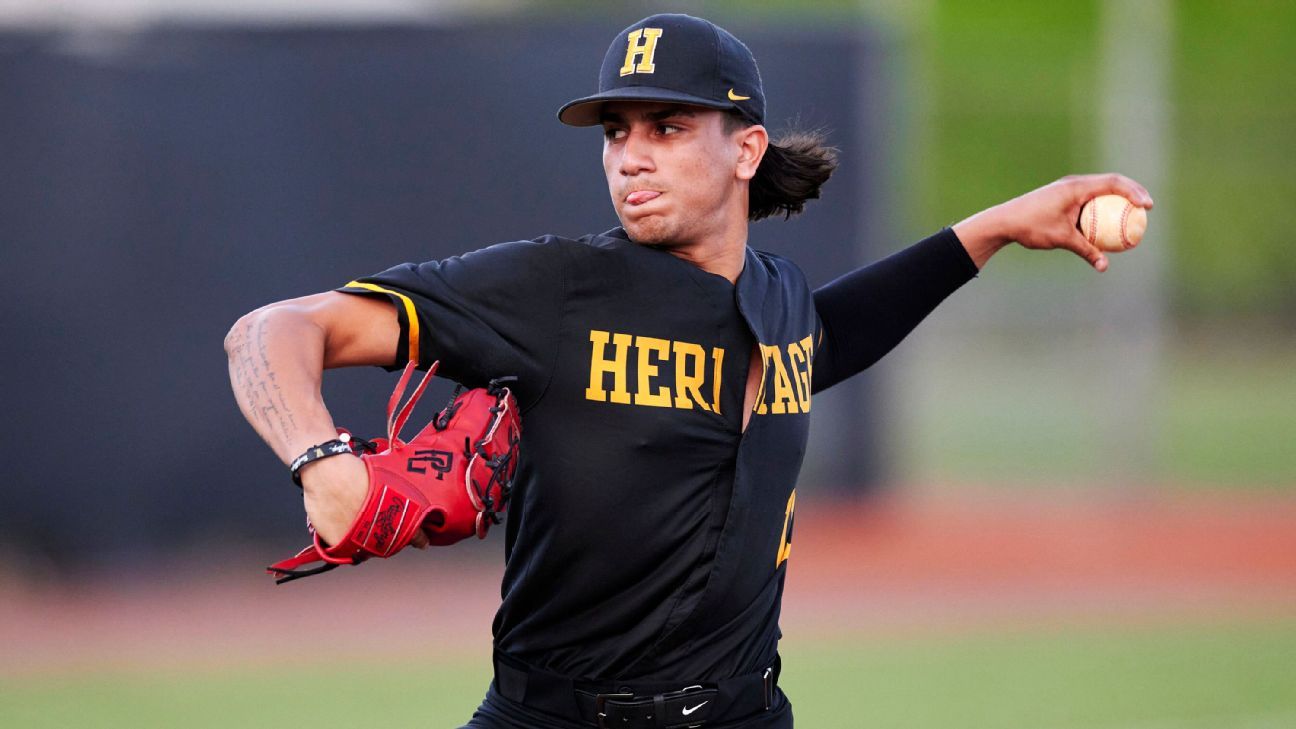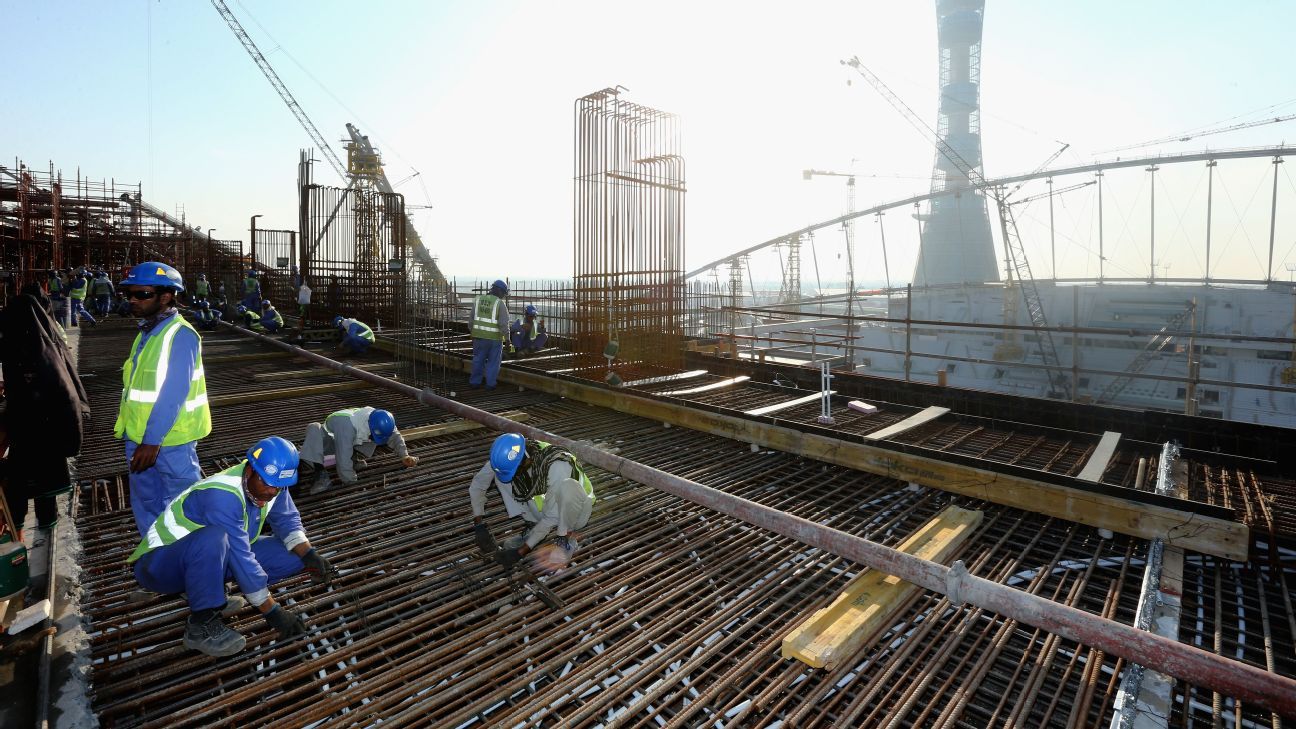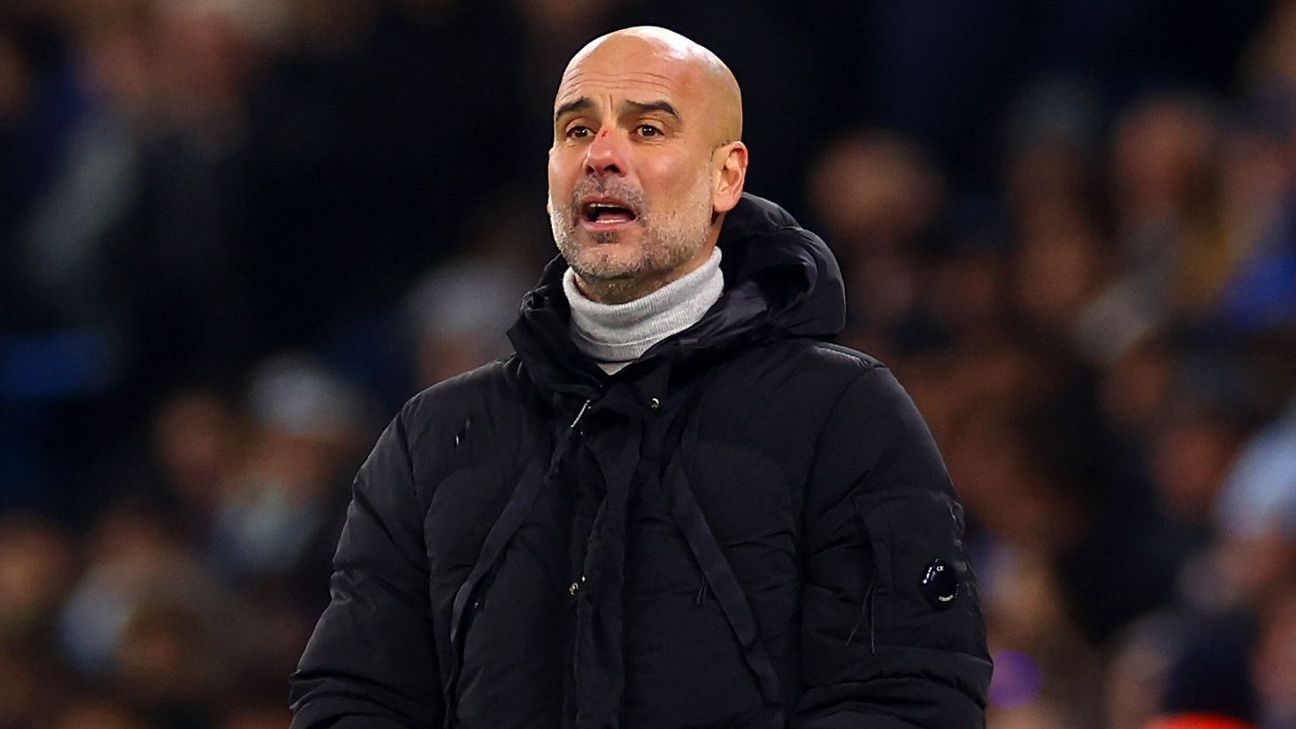
I WAS STANDING behind home plate on Feb. 24 at Buford High School in Georgia watching right-hander Dylan Lesko, the best prep pitching prospect in the 2022 MLB Draft, arguably the best prep pitching prospect in years. A scouting director of a team picking in the middle of the first round took his position next to me and asked, "What are the chances this guy gets to us?"
At this point, I had him securely in the top 10 picks, with a chance he goes in the top five. "Unlikely," I said, then paused. "But, I mean, he's a prep righty, you never know."
He chuckled in recognition. "Yep, we chew 'em up and spit 'em out, just like running backs."
Two months later, Lesko had Tommy John surgery. He is now projected to go in the middle of the first round.
AROUND THE SAME time that Lesko left a start early with forearm soreness, the prep pitching prospect ranked right behind him was seriously thinking about cutting his own high school season short.
Brandon Barriera, a senior left-hander who I ranked 13th in my April draft rankings, was "scout-famous" -- local, regional and national scouts and media have known his name for years. As a freshman, he was into the low-90s playing at American Heritage, a high-profile south Florida school that produced Padres first baseman Eric Hosmer and Red Sox top prospect Triston Casas. I saw Barriera pitch four times last summer, and he had multiple high-profile matchups this spring against pro prospects that drew dozens of scouts.
On April 12, six days after the outing in which Lesko was hurt, Barriera notified scouts that he would be making two more starts, then shutting down for the remainder of the season to prepare for July's MLB Draft (he is committed to play at Vanderbilt if he ends up not signing). Barriera would still be a part of all team activities, he said, but was effectively skipping one regular-season start and the postseason (which could mean as many as five additional starts). No amateur pitcher had ever made this specific decision before.
"I'm doing what's best for myself," Barriera said in an interview with ESPN last month. "You see all the Tommy Johns this year, even for college guys, they were so close. You have to ask yourself if it's worth it."
Though Lesko's injury certainly weighed on him, Barriera said this decision wasn't purely reactionary. "I had been thinking about this for a while," he said. "It wasn't just one morning I came up with it. Every night I was sitting with my parents and talking until we came to a peace about it."
A number of sources I spoke with think that Barriera will be an early domino to entice more pitchers to take their futures more into their own hands, much like college football players skipping their teams' bowl games has become practically the norm. Running backs only have so many hits they can take, pitchers only have so many fastballs in the tank, and we don't know what that number is, so they need to be timed well.
With pitchers throwing harder at younger ages and the incentives to throw near year-round, this attrition problem isn't going away. I asked an NL GM how much he'd pay for a magical algorithm that would tell him a pitcher's next five years of health. His answer: "Everything we have."
WHILE SPEAKING WITH a scout about the prep pitching class, he told me to look at the track record of the prep pitcher who gets the biggest bonus in a draft and compare how many of them were considered the best in their class a few years later. As someone whose job it is to cover the MLB Draft, even I was shocked by the results.
If we start with 2016 (who is best from the 2017 class is still a toss-up) and go back 10 years through the 2007 class, the prep pitcher that got the highest bonus was actually the best prep pitcher in the class ... once. And, really, you could argue the answer is zero.
That distinction depends on whether you think Lucas Giolito or Max Fried (the two top prep pitcher bonuses in 2012 -- Fried got $3 million to Giolito's $2.925 million) is the better pitcher. In spirit, let's count it, since the clear two best in performance also got the top two bonuses, and they're nearly tied on both accounts.
But in most years, it's not even particularly close. The next best comparison is Jameson Taillon, who got the highest prep pitcher bonus in the 2010 class, $1.25 million over the next closest pitcher. Taillon was seen as one of the best pitching prospects in years, chosen second overall between Bryce Harper and Manny Machado. He's shown flashes of that in the big leagues, but he's been easily bested in career value by Robbie Ray (17th-highest prep pitcher bonus in the 2010 draft) and Noah Syndergaard (24th).
You could take a number of lessons here, but the most obvious one is that pitcher development (particularly with teenagers who sit in the mid-90s) is still incredibly hard to predict. In fact, the idea that any club would bet $6 million-plus that it knows which one is the best of the group seems unreasonably risky.
Confidently projecting and drafting the best high school pitcher in the draft, when you can just draft a college pitcher or any position player, seems to be pure hubris. Some teams (and not just the usual numbers-obsessed teams you're thinking of) have told me they will not draft a high school pitcher in the top 10 picks under any circumstances.
Taking this 10-year sample as representative of the showcase circuit setting from which all teams now scout high school players, if you wanted to make that bet, there's been a 10% chance you're right (Fried/Giolito in 2012) and a 60% chance you're extremely wrong: Casey Kelly (2008), Jacob Turner (2009), Kohl Stewart (2013), Tyler Kolek (2014), Kolby Allard (2015) and Riley Pint (2016).
So: If many of the best in the world at scouting players feel like they're flying blind with prep pitchers when the stakes are the highest, is it really that surprising that a prep pitcher may want to play it safe at a key juncture in their career? Shouldn't the pitcher be afforded the same grace that the risk-averse teams get?
FOR A PITCHER like Barriera, one more postseason start wasn't going to move him up the draft board. Anyone whose opinion mattered had already seen him pitch a number of times over the last year. In fact, Barriera's scouting report hasn't changed much in more than a year, which is also pretty rare for a pitcher this young.
Interested teams piled in for Barriera's final two starts, and reports were positive, as they had been all spring. He has four pitches headlined by a fastball that's into the high-90s, plus a slider, curveball and changeup that all flash above average-to-plus potential along with the components to project starter-level command. Barriera's changeup was used rarely in high school games and isn't needed in shorter showcase settings, but some scouts walked away from spring outings saying it's his best pitch. It's also notable that his curveball (a somewhat new pitch which has cracked 3000 rpm) and slider (with a sweepy break at 0:16 below) have distinct shapes from each other, which is rare for a hard-throwing prep pitcher.
I was at prep LHP Brandon Barriera's first private bullpen after shutting down for draft preparations; more on that later this week.
Here's some video from that bullpen and other clips from the summer. He didn't throw a curve much in the summer but now has two distinct breakers. pic.twitter.com/Gz032uJR6x
— Kiley McDaniel (@kileymcd) June 13, 2022
Barriera peaked at 98 or 99 mph this spring, depending on which guns you were looking at. When I asked if he wanted to hit 100 mph, he said yes almost before I finished asking the question -- despite the fact that velocity is the single most predictive factor for future injury.
"I think of it like I'm two guys, a split personality," Barriera said of the dichotomy of sitting out to stay healthy while aiming long-term at increasing his velo. "On the mound, I'm relying on muscle memory and attacking instinctively. If it's before the game, just playing catch, or post-game, doing recovery, I'm a totally different guy, thinking about stuff and analyzing the process. You have to separate them."
Ending his high school season didn't mean Barriera stopped pitching. The same draft models that use empirical data to steer teams away from picking prep pitchers early in the draft also get more confident when the pitcher comes with lots of strong advanced pitch-tracking and sports science data, which Barriera can continue to collect in the coming months.
I spoke with him after watching a private bullpen in May, his first after shutting down. The pitch sequences were called out by his private pitching coach Nick James, every pitch's key data measured by a Rapsodo unit. Together, the pair were cruising through short "innings" in the low-90s for 40 or 50 pitches total at a private facility called The Hangar.
It was obviously a much lower stress outing than a playoff game for American Heritage, but even throwing this hard came with some injury risk -- which means a real monetary risk. If a mid-first round pick has Tommy John surgery right before the draft, it would take a roughly $5 million bonus to a roughly $3 million bonus. And that signing bonus is even more important for pitchers -- given the risks of pitching versus playing the field, it's also more likely that an elite pitcher will only get paid well once in his career.
Over the past two years, I ranked the roughly 10 aces in the big leagues around the beginning of the 2021 and 2022 seasons. For that piece, we also worked on defining an ace, which can go a lot of ways -- but something I learned while working for the Braves years ago was that no matter how you define an ace, roughly half of them have had Tommy John surgery. The rate is much lower for lesser starting pitchers. In my mind, the explanation is that surgery doesn't necessarily derail an ace's career -- but the less talent you have, the more it will impact your future. Those lesser pitchers who had surgery might never even have made it to the bigs, let alone a list like that.
That's what could be at stake for a pitcher like Barriera, who said he tries to put that kind of risk out of his mind. "What you put out there is what you get back," he said. "You can't think about it or play scared. If it's gonna happen, it's gonna happen. You can get Tommy John throwing 88 [mph]. You can't run from it."
I asked a couple GMs and a number of scouts how they would handle this situation if it was their son, and they generally agreed that Barriera's decision was the right pure strategic move for his future, limiting high-stress pitches near draft time when MLB teams already had plenty of information on him. But many of those same people said they'd still have hesitated to advise him to do it because of the blowback.
I definitely heard from a minority of scouts who saw it purely negatively, as well. "So he doesn't want to compete?" "This is just another me-first type." "He's secretly injured and they aren't telling us?" (If you've paid attention to player empowerment progress in other sports, this shouldn't be very surprising.)
Barriera pays little mind to those kinds of critiques. "I've been to every showcase, every tournament I need to go to, shown everything I need to, to answer all of those questions," he said. "I'm still competing, coming in here and fine-tuning and improving every day. I'm taking summer classes at Vanderbilt in July. I'm not sitting on the couch and shutting it down until next spring."
STILL, BARRIERA'S DECISION to completely sit out the end of his high school season is pretty much unprecedented. The only similar example that scouts can recall is Reds RHP Hunter Greene shutting down while playing for Notre Dame High School in Southern California before the 2017 draft. Teams were notified on April 27 that he wouldn't be pitching again (he did continue to play shortstop), though a source told me that teams picking high that year were privately told by Greene's camp at the beginning of the spring to prepare for that.
Less than two months later, Greene went second overall to Cincinnati, signing for the highest bonus in that year's draft ($7.23 million). He had Tommy John surgery less than two years later, waited through the canceled 2020 minor league season, then returned to action in 2021, eventually making his big league debut this season.
Greene's outcome so far -- big league debut at age 22 in a rotation, performing pretty well with room to grow -- is a clear outlier, considering where he was drafted. But it's also a model for how to manage risk, even with an elbow surgery mixed in.
Greene avoided injury at the end of his high school season, maximized his draft outcome, had surgery in pro ball while getting top-notch instruction and care and came out the other side looking something like the most optimistic pre-draft projections. But there are dozens of other examples of pitchers turning down $2 million-plus out of high school and settling for much less out of college, or having surgery just before the draft, or washing out in the minors, or being the victim of poor development, or repeated high pitch counts, etc. derailing them from reaching their potential.
There are so many ways to fail, and every scout, executive, coach, agent and player has seen plenty. Avoiding injury is still so fraught that tens of billions of dollars of incentives haven't helped the industry make much headway, so young pitchers are tasked with managing risk and timing when they hit the market to maximize what could be their only pay day.
Total success for a top of the first round prep pitcher seems like a miracle, with a handful of examples per decade of models like Zack Wheeler (third-highest prep pitcher bonus in the 2009 draft) and Madison Bumgarner (third-highest in the 2007 draft), or Giolito and Fried. Maybe soon, Hunter Greene reaches that level. Maybe one day, Brandon Barriera will, too.















 Phone: (800) 737. 6040
Phone: (800) 737. 6040 Fax: (800) 825 5558
Fax: (800) 825 5558 Website:
Website:  Email:
Email: 






